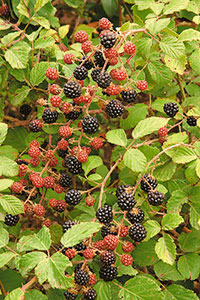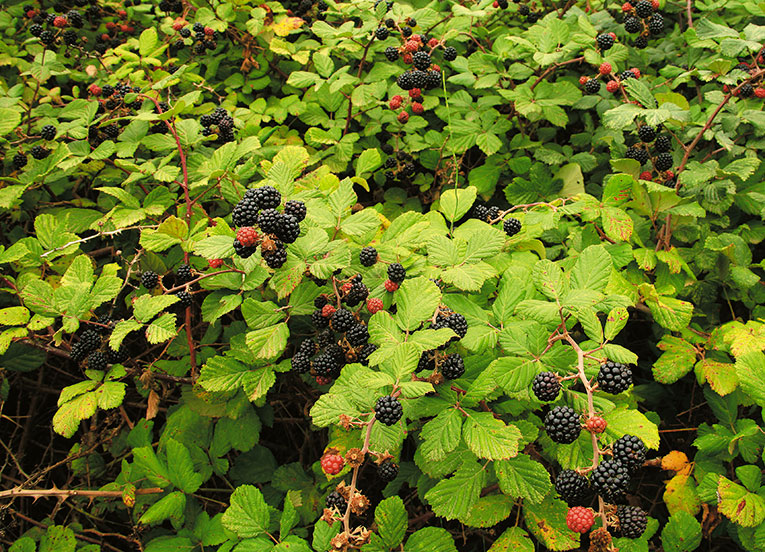 © V. Rodríguez |
||
| Pressure grew by the minute and, although he was the son of God the Father, each of the curved and sharp thorns tearing the skin spilled a drop of blood.
But… let’s start from the beginning. Despite being fathered by God the Father and a mortal virgin, despite having travelled as a little boy to far-off lands, and having blessed the wine several times, he was predestined to suffer torture before dying, to be raised on the third day and to climb to heaven to sit at the right hand of the Father, of his father. As the reader may have guessed, we are talking about Zeus (Deus), the mortal Semele, and their child, Dionysus, god of wine, fertility and generous nature, who people in Valencia honour on October 9th under the form of Saint Denis. Once, the romantic and lustful Dionysus chased a nymph with whom he was infatuated to the edge of the forest. Trying to flee, the young nymph got hooked, and her flesh lacerated, in a bush, the leaves of which she thought were elm saplings. When she saw the god move closer, she delicately blushed; and Dionysus, pleased, touched the thorny bush with his wand –the thyrsus–, and it got covered with flowers, rosy as the cheeks of the nymph and, later, of fruit temporarily as ruddy as spilled blood. We refer to the bramble or blackberry, Rubus ulmifolius, the most eminent representative of its genre in Mediterranean territory, and also the most common and abundant rosacea in the low damp mountain, where it coexists with others of its kind. The Botany Bramble Defined typically as Rubus foliolis petiolatis supra glabris subtus tomentosis, caule suffruticoso erecto 5-angulari, aculeis recurvis, calyce reflexo, our precarious Latin education advises more verbose descriptions to gain knowledge of the bush. The secret of the bramble’s success comes from the fact that, perhaps unsatisfied by the level of spread offered by the animals that eat its fruit, it combines that with an aggressive vegetative dissemination. Thus, during the autumn it shoots out leafless vines, tender but sturdy, the turions, up to four metres long, which arch, bend and take root upon touching ground, in a kind of recurrence which allows for ad infinitum clonal multiplying. |
«The thorny bush got covered with flowers, rosy as the cheeks of the nymph and, later, of fruit temporarily as ruddy as spilled blood» 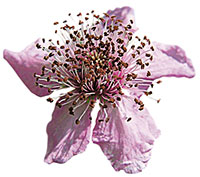 © Mètode
«To get trapped is to suffer tens of stabbing tears, merciless bleeding cuts which take a painful transit tax of flesh and skin pieces»
|
|
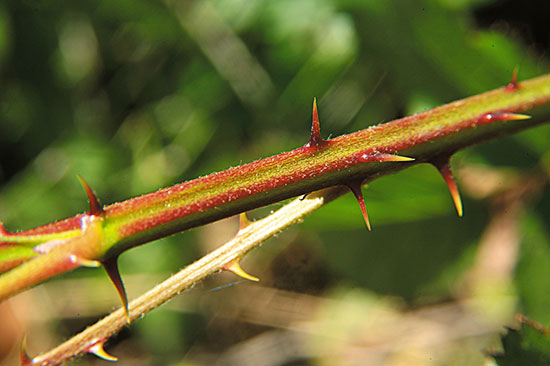 The stems of the bramble are protected by strong, rigid and sharp excrescences of superficial nature, the thorns, which also decorate the stalk and central nerve on the reverse of leaves. The ensemble forms fences or hedges both intricate and impregnable. / © V. Rodríguez |
«Plinius the Elder understood the bramble as a moral compensation from nature, which “… did not create brambles just out of wickedness, but it gave them blackberries to serve as food for men”» |
|
|
The new shrubs are formed by numerous stems (caule suffruticoso erecto), hard, flexible and ducted in pentagonal shape (5-angulari); these stems are protected by strong, rigid and sharp excrescences of superficial nature, the thorns, which also decorate the stalk and central nerve on the reverse of leaves. The ensemble forms fences or hedges both intricate and impregnable, in such a way that very few skins can defy the dangerous janbiyas of the bramble. To get trapped is to suffer tens of stabbing tears, merciless bleeding cuts which take a painful transit tax of flesh and skin pieces which were previously part of legs, snouts or paws of the animal that, unwisely, got into the trap. That is why these hedges –up to three metres high and even wider– serve small birds like the common whitethroat, Sylvia communis, as a nest, as they find in it an equally adequate and deterrent refuge. Later, when spring arrives, the bramble turns into a mobile plant: were we to register it with a «time-lapse» camera [photography at intervals projected later as a film] we would see the turions operate as explorers investigating the surroundings while they write, with slow aerial calligraphy, the desire to find appropriate support for their expansionist instincts. Although the movement cannot be perceived with the naked eye, it is much faster than most plants, and it can reach five centimetres a day! Each one of the stems is equipped with sharp thorns curved backwards (aculeis recurvis), so they can climb walls and trunks and, where they touch ground, they shoot out small roots and start extracting water and mineral salts from the bridgehead where they settle. The result is that, if they are not stopped on time, brambles destroy, invade and displace everything in their path. The bramble established its rule and it is not easy to cast it out, because is resists with guaranteed success in front of sickle, fire and weed-killer. Compulsive invader, it occupies shamelessly the margins of crops and roads, of ditches and terraces; and also ravines, the surrounding of springs and small streams, the base of walls and abandoned plots. In short, we find brambles wherever there is humidity, high temperature, good light and deep soil. Only shadow bothers the bramble: heliophilous as it is, it does cannot stand the shadow of trees and so it stops at the forests door, where it acts as a defensive edging. The bramble’s vigour has broken the limits of the Mediterranean region: a great part of Europe, the Canary Islands and several South-American countries learnt about its conquering ambition, despite the fact that goats, as well as big game, feed with delight on the leaves of saplings. Saplings, it needs to be said, that can be eaten as a substitute for asparagus; with one condition, though: they need to be carefully peeled and preferably boiled. The leaves of the bramble are divided in three or four leathery leaflets, which sprout from the same point; they are ovoid, with a serrated brim, and abruptly narrow at the tip; in other words, they look like the leaves of an elm (Ulmus), being the reason that the specific ulmifolius accompanies the generic Rubus. The upper face of each leaflet, of a dark green colour and protected by a wax layer, is hairless (supra glabris), while the lower has a whitish look due to thin hairiness or tomentum covering it (subtus tomentosis). With some frequency, as clear sign of the attack of a parasitical fungus, small red or violet stains can be found on the leaflets. In any case, the bramble’s leaflets have a reputation for strengthening the gums when chewed and for fight against mouth sores. |
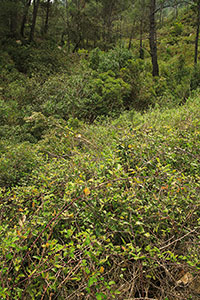 Compulsive invader, it occupies shamelessly the margins of crops and roads, of ditches and terraces; and also ravines, the surrounding of springs and small streams, the base of walls and abandoned plots. In short, we find brambles wherever there is humidity, high temperature, good light and deep soil. Only shadow bothers the bramble: heliophilous as it is, it does cannot stand the shadow of trees and so it stops at the forests door, where it acts as a defensive edging. / © V. Rodríguez
|
|
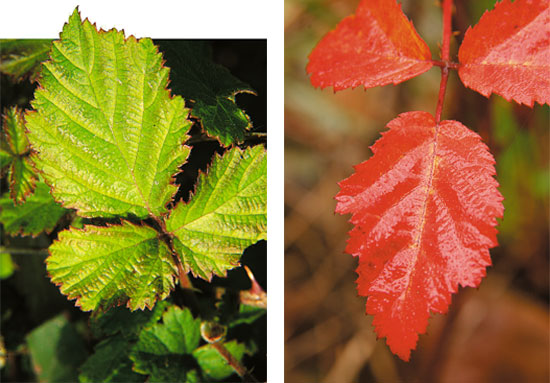 The leaves of the bramble are divided in three or four leathery leaflets, which sprout from the same point; they are ovoid, with a serrated brim, and abruptly narrow at the tip; in other words, they look like the leaves of an elm (Ulmus), being the reason that the specific ulmifolius accompanies the generic Rubus. / © V. Rodríguez |
«A parable uses the bramble to portray the mechanisms of political elections, where someone often comes to power under false pretence or simply through threats or extortion» |
|
|
The beginning of the summer is the signal for lots of magnificent bouquets to sprout at the end of the new branches, which will ornate the bramble from June to August. In each flower, a calyx formed by five velvety sepals facing downward (calyce reflexo) protects a corolla with five white or pink petals, canonical example of the typical fivefold of rosaceas. At the centre of the group lots of stamens and a pistil appear, in the base of which a discrete and sweet fountain of nectar provides fuel to the insects taking part in pollination: furthermore, the great amount of pollen will facilitate a fair distribution: one part for the eager female ovaries and another one for the transporter insects, as nutrition source. This pollen, grouped in small grey-green balls, can be found in suspension in summer honey and it contributes to give it quality. The result of such an intense bustle and the resulting pollination are the pleasant blackberries, which the Lombard Plinius the Elder understood in the 1st century AD as a moral compensation from nature, which «… did not create brambles just out of wickedness, but it gave them blackberries to serve as food for men» (Naturalis Historia Liber, xxiv: lxxiii: 117). The name of blackberry in different Romance languages comes from the Latin morum. It evolved into Spanish and Italian mora, Occitan and Portuguese amora, and French mûre. The blackberry is a globular little head formed by a mass of small drupes, each one with an indiscernible pip, arranged on a white and fleshy cushion, edible as well. Originally green, it goes through a ruby red until it reaches with ripeness a purple as dark as mulberries, or even such an intense black as its name indicates, described by Pérez Galdós in Marianela: «[…] there were thickets of bramble loaded with the black fruit beloved of children» (capítulo xiv). This spectacular chromatic transformation is amusingly portrayed in the following riddle from the region of La Mancha: Verde fue mi nacimiento, colorado mi vivir [Green was my birth, coloured my life The late-summer peak ok blackberries, which turns most of the clothing unnecessary, explains the Valencian proverb «mores d’albarzer, sastres i modistes al carrer» (bramble blackberries, tailors and dressmakers on the streets). In this sense, it is not strange that the French republican calendar, based on the description of natural manifestations –of the region of Paris– dedicated the ninth day of the month of Thermidor to the mûre, in a similar way as Catholics dedicate this day (July 27th) to Saint Symeon the Stylite. Regarding the chemical composition of blackberries, the small amounts of citric acid they synthesise give them a slightly acid and refreshing sweetness, they are pleasant as fresh fruit and suitable for jams, marmalade and syrups. Besides, the juice of blackberries has been used to colour grape wine, to dye wool and, fermented, to make blackberry juice. The Genesis Blackberry Dyonisus was not the only god who was an enthusiast of brambles. According to Genesis 22:13, some Elohim played the cruellest of known pranks on Abraham: after demanding the sacrifice of his son Isaac, he exonerated him at the last moment through the action of Archangel Michael «who is like God», who stopped the filicide arm. Perhaps everyone thought, avant la lettre, Oscar Wilde’s apothegm «Life is far too important a thing ever to talk seriously about», but the fact remains that the fanatically gullible Abraham must have got so terribly shocked that, to release some stress, Elohim directed his gaze towards an animal apt for a barbecue, a lamb; wrapped, it could not be otherwise, in the branches of a bramble. Such a macabre episode could not leave artists numb. We have to foreground one in particular, as it marks an inflection point in art history, the start of the Renaissance in Plastic Arts: the Sacrifice of Isaac (1401) by Lorenzo Ghiberti, a bronze relief decorating the second door of the baptistery of San Giovanni, in the Florentine Cathedral of Santa Maria dei Fiori. |
||
| The Bramble as Political Allegory
In the bible’s Book of Judges, the bramble gets the doubtful homage of being used as a bitter political allegory. The verses that talk about it (9:8-15) start describing the cruel try of Abimelec to unify the tribes of Israel, which ended with the death of his brothers and the escape of the smallest one, Jotam. Later, he summoned the folk of Siquem and said: Once, the trees decided to elect a king, and they told the olive tree: «Reign over us». But the olive tree said to them, «Should I stop giving my oil that honours both God and man, and rule over the trees?» Then the trees said to the fig tree, «Come and reign over us». But the fig tree said to them, «Should I stop giving my sweetness and my good fruit, and rule over trees?» Later, the trees said to the grapevine, «Come and reign over us». But the grapevine said to them, «Should I stop giving my wine that cheers both God and man, and rule over trees?» Finally, all the trees said to the bramble, «Come and reign over us». The bramble said to the trees, «If you really are anointing me as king over you, come and find refuge in my shade. But if not, may fire come out from the bramble and consume the cedars of Lebanon». As we can see, this kind of parable uses the bramble to portray the mechanisms of political elections, where someone often comes to power under false pretence –the shadow, almost non-existent and practically unreachable– or simply through threats or extortion. |
||
|
|
||
| The Brambleberry Zeus might have Eaten
We left for the end maybe the most unsettling problem, the origin of the specific name, idaeus. For most botanists it is a locative referring the stunning mountain in the middle of Crete: Ida, current Psiloritis. It is so majestic that its name was used as an anthroponomical prefix for mythological characters such as King Idomeneus, one of the participants in the Homeric war of Troy. Ancient Cretans worship the peak because they thought that was the place Zeus (Jupiter) was born and that, fleeing from his father Cronus (Saturn), he had found refuge in one of the caves in the mountain. This haven let him survive while he grew thanks to the milk of the goat Amalthea –milked by the nymph Ida– and the fact that minor divinities, the Curetes, muffled the noise of his crying. Were they real –not only real nor divine–, the Curetes, the nymphs, goats, Idomeneus and Zeus itself would have earnestly eaten the precious raspberries. But alas! If we check the species distribution map, it is not present in Crete, but it is in Anatolia, very close to ancient Troy. And who would have thought so! There is also a mountain called Ida there, also very rich in mythological referents. In fact, for other botanists, this is the one Plinius recalled when talking about the Idaeus rubus. (Full article in Catalan) |
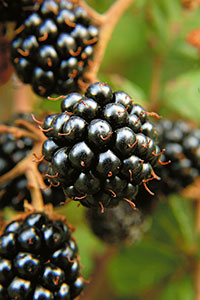 The blackberry is a globular little head formed by a mass of small drupes, each one with an indiscernible pip, arranged on a white and fleshy cushion, edible as well. Originally green, it goes through a ruby red until it reaches with ripeness a purple as dark as mulberries, or even such an intense black as its name indicates./ © V. Rodríguez «Were they real, the Curetes, the nymphs, goats, Idomeneus and Zeus itself would have earnestly eaten the precious raspberries» |
|
Search
© Mètode 2007 - 55. Gene, Ethics and Aesthetics - Issue 55. Autumn 2007

